Our Island Bears
/Adam Haecker, 2017
Black bear caught by a camera-trap at Big Bay State Park; Photo by Erik Olson, Northland College
For many of us they cause both fear and fascination. We also tend to think of them as both cuddly and contemptuous. But for all of us, we respect their domain, because they are among the largest mammals in North America. I’m talking about the American Black Bear.
On Madeline, people rarely see them. And yet, according to a fact sheet published by the Apostle Islands National Lakeshore (National Park Service) Stockton Island supports one of the most concentrated populations of black bears in the world. In fact, the bear population on Stockton skyrocketed in a ten-year span several decades ago. “A study of Stockton Island bears revealed that the population grew from two animals in 1984 to a high of 31 non-cub bears in 1994,” states the fact sheet. But those numbers have since dwindled through self-regulation, as black bears are sensitive to over-crowding and make every attempt to avoid human contact.
Speaking of contact, people are always encouraged to follow several key steps to avoid confrontation with black bears. We’ve all heard the warnings from a concerned parent or perhaps a dutiful park ranger when entering the wilderness. How about: ‘Never approach or feed a bear’, ‘Keep a distance of at least 50 yards’ and one of my favorites, ‘If you encounter a bear, make yourself look big.’ The latter has always been a challenge for me, given my 5’6” frame and my natural fear of anything larger than a field mouse.
And not to digress too much, but I do have a short story about an encounter that I had with a black bear while running on the Capser Trail on Madeline last summer. I was rounding one of the blind corners on the trail close to Middle Road, when I saw what looked like a grossly overfed black lab. But, to my limited knowledge, black labs don’t snort, and they certainly don’t take up most of the trail when lumbering down it. Then our eyes locked. And as you can imagine: I instantly had a vision from childhood of that moment when you ride your three-wheeler into the street with an oncoming car. But just as suddenly, the male (I’m guessing), turned and bolted for the nearest offshoot from the trail like a scaredy-bear. I stood in astonishment. Here I am, 5’6” frame and all, and about as imposing as a sack of flour, scaring off a 200-pound behemoth of the wilderness. I caught my breath, and quickly made my way back home.
Adult male black bears range in weight from about 130 to 660 pounds, and females range in weight from 90 to 175 pounds, according to the International Association for Bear Research & Management, a non-profit of professional biologists and wildlife managers who are dedicated to the conservation of all bear species throughout the world. The association also states that a medium-sized black bear is typically black with a brown muzzle, however, some bears can be chocolate or cinnamon brown in color. They also have strong, highly curved claws, and the profile of their face is convex, compared with a more concave profile of a brown (grizzly) bear. And, as a kicker: They are excellent swimmers. However, despite these fascinating details, I can certainly tell you with conviction that the physiology of a bear’s jaw isn’t the first concern when you come nearly face-to-face with it in the wild. Looking big is first…really big.
Erik Olson, Assistant Professor of Natural Resources at Northland College in Ashland, believes there is a genetic connection between the black bears in the Apostle Islands and the black bears on Madeline. He also says that little is known about the population on Madeline because it is not part of the Apostle Islands National Lakeshore. “Based upon previous studies, we know that there has been a meta population of black bears amongst the Apostles that proves that they have formed a genetic, connected community,” Olson says. “Therefore, we can only infer that such a genetic exchange exists between the Apostles and Madeline, even though we don’t have the hard studies to prove it.”
And although scientists and researchers have kept a relative track of the historical number of black bears on the other islands, there hasn’t been any such documentation done on Madeline, according to Olson.
That’s about to change, however, as Northland College was one of 30 recent applications to receive grant funding from the Natural Resources Foundation of Wisconsin through the 2016 Besadny Conservation Grant Program. Northland’s research project titled “Wild Madeline — Assessing the Wildlife Presence and Abundance of Madeline Island” will include a camera-trap survey to determine which animal species are present on the island, as well as their abundance (population numbers). These statistics will then be compared with the other islands and the mainland.
I’m sure that many of us will be interested in the results of Northland’s research project. I know that I will. Species diversity is critical to ecological balance. We can only hope that a healthy population of creatures shares our home on the rock. And personally, I would like to meet the rest of scaredy-bear’s family.





























